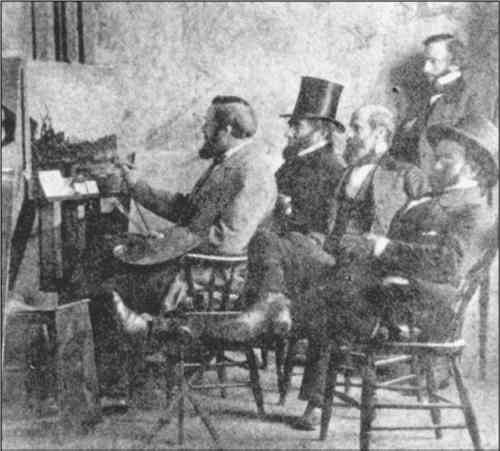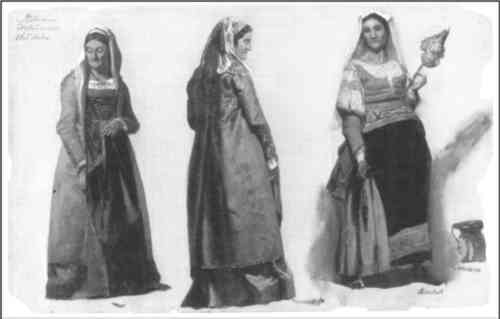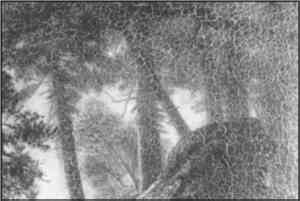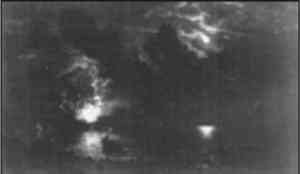BIERSTADT AND OTHER 19TH-CENTURY AMERICAN PAINTERS IN CONTEXTLANCE MAYER, & GAY MYERS
3 BIERSTADT'S TECHNIQUEAn 1859 stereograph view of Albert Bierstadt and his New Bedford patrons (fig. 2) gives several clues about Bierstadt's working methods. The painting Thunderstorm in the Rocky Mountains (1859, Museum of Fine Arts, Boston) is on the easel. An examination of the original stereograph (William Schaefer Photographs and Fine Art, Chester, Connecticut) shows that the painting is not very far along. The branches on the left are just single strokes; they will eventually become much more twisted and complex. The artist has begun the area of water at the lower right with a series of strokes, and he has not yet begun painting the deer on the right. It is tempting to try to decipher the small square shapes resembling
3.1 STUDIESBierstadt produced a variety of different kinds of studies. Italian Costume Studies(fig. 3), dating from his first trip to Italy in 1857, is a very straightforward study in which the artist set down details of costumes that he later incorporated into larger paintings. It is done in oil on paper, but unlike some other studies,
In the case of Italian Costume Studies, Bierstadt applied a natural resin varnish layer locally in order to saturate or “wet up” the design. The varnish can be seen as a faint line of discoloration around the figures and as uneven gloss in reflected light. It is likely that after Bierstadt painted the image it was too matte, or “sunken in,” and he needed to varnish the design in order to see the details in the darks. Another case of this technique can be seen in the study Ox (undated, Oakland Museum, Kahn Collection), where an outline of varnish can also be seen. Bierstadt must have varnished the study of the ox before it was quite dry, because one can clearly see where the pigment was picked up and has bled into the varnish layer, especially around the head of the animal. Even watercolor artists sometimes felt this need to add a coating to better saturate works of art on paper. For example, a water-color and gouache painting by Bierstadt's predecessor in the West, Alfred Jacob Miller (1810–74), Trappers Making their Escape from Hostile Blackfeet (undated, Beinecke Rare Book and Manuscript Library, Yale University), shows that the artist applied a glossy gum coating locally in the darker areas so that he could have a greater range of values in the darks. On some of Bierstadt's studies the paper was prepared with a thin white oil ground before painting. This is true of a highly finished study of South Dome, Yosemite Valley (Richard Manoogian Collection), which is inscribed in The large number of preparatory sketches and studies that Bierstadt made became a topic of discussion during the artist's lifetime. It was reported that 50 studies were made for his 1858 painting Lake Lucerne, now in the National Gallery of Art (Home Journal, April 3, 1858, quoted in Anderson and Ferber 1990). Six years later, The Rocky Mountains, Lander's Peak was criticized by American pre-Raphaelites who thought that “twenty times the study that the artist has given to this picture,—study represented by actual sketches, built upon a previous ten years…would not have justified him in attempting to fill so large a canvas” (New Path, April 1864, 161, quoted in Anderson and Ferber 1990, 194). By 1870, perhaps in response to this criticism, a kind of “sketch escalation” can be seen, and publicity around The Emerald Pool (1870, Chrysler Museum) claimed that 200 studies were made for it (Hendricks 1974). 3.2 FINISHED PAINTINGSIt is interesting to examine closely the surfaces of some of Bierstadt's completed paintings, because many of his strongest critics disliked his painting methods and associated them with techniques taught in D�sseldorf, where Bierstadt had studied. As the D�sseldorf style, which had been much admired in New York around mid-century, fell in esteem during the following decades, both Bierstadt and the D�sseldorf school were criticized for “conventional lifelessness” and “hardness” (Jarves [1864] 1960, quoted in Hendricks 1974, 144; The Albion, 11 May 1867, quoted in Hendricks 1974, 164, n. 29). Bierstadt's straightforward method of applying paint can be seen in many of his paintings. For example, in The Matterhorn (undated, private collection, on loan to the Lyman Allyn Art Museum), most of the painting was done wet-into-wet. Although the brush strokes accurately describe the subject, the strokes are rather repetitive and would not be called beautiful or interesting in their own right. In some passages, especially in the sunlit mountainside, the paint appears to have been quite viscous and sticky, forming small, stiff peaks as it came off of the artist's brush. Parts of the rocky foreground in the lower left were clearly painted in several layers over paint that was already dry, and there is some traction crackle in the nearby dark evergreen trees. Many of Bierstadt's paintings that are painted without excess medium or unusual added media are also in very good condition. However, his technique varies enough that this is not always the case. For instance, some of the earliest paintings done in Europe, such as A Rustic Mill (1855, private collection), show severe wrinkling, probably from excess oil in the paint. A few of Bierstadt's
In the Yosemite Valley (1866, Wadsworth Atheneum), demonstrates Bierstadt's typical technique for his medium-sized paintings. The technique is for the most part simple, using opaque paint, with few brush strokes that have a life of their own. Critics at the time sometimes called his paint application “hard” or “dry” (Watson's Weekly Art Journal, May 20, 1865, quoted in Hendricks 1974, 158, n. 20). One wonders whether some critics may have associated the lack of liveliness or personal expression in Bierstadt's paint application with a lack of feeling in the painter. Even in the painting of the trees, the brushwork is very simple. It shows paint application that would seem old-fashioned, as more painterly tricks of impasto with glazes dragged over them came into fashion with the rise in popularity of the Barbizon School. By the 1860s, George Inness (1812–94) was being praised for his “rugged handling” and “great sprawling marks of the brush” and, significantly, for his depth of feeling as well (Burke and Voorsanger 1987, 82). In the Yosemite Valley also shows one of Bierstadt's mannerisms. He uses a very thin layer of paint, having some opacity to it and tending toward brownish, to represent the surface of a body of water. A study of the surfaces of Bierstadt's paintings illustrates Baigell's contention (1981) that it was probably not just the amount of detail in Bierstadt's paintings that some critics did not like—other artists painted with as much detail—but it was also the fact that Bierstadt's surfaces are not variegated and that large areas of his paintings are relatively uniformly painted. In his larger paintings, unlike his small studies on paper, Bierstadt rarely dragged his paint over the texture of the support to enliven or vary the application of his paint. Similarly, in his larger paintings, he seldom glazed over texture that he had made beforehand with thick layers of impasto or painted with colors that were thin enough to show the marks of his brush. It may have hurt Bierstadt in the eyes of the critics that his technique not only was simple and methodical but looks simple and methodical as well. The average viewer could be baffled by how the built-up texture and glazing of some other artists was done but could well imagine how Bierstadt's work was done, stroke by stroke. On the other hand, when some critics said they disliked the way that Bierstadt put on paint, they appear to have been criticizing his manner of representation—they were saying that he was not good enough at putting paint on canvas to make a successful illusion of the object represented. For instance, in 1863 a critic said of The Mountain Brook (1863, Collection of Gil Michaels): “Again, the sense of paint is too strong…. The large boulder in the centre is not stone-like in texture, but rather like a huge mass of gray paint” (New York Leader, April 18, 1863, quoted in Anderson and Ferber 1990, 193). Similarly, it was written in the American pre-Raphaelite journal New Path that Bierstadt's The Rocky Mountains, Lander's Peak would have been better “if the marks of the brush had, by dexterous handling, been made to stand for scrap and fissure, crag and cranny, but as it is, we have only too little geology and too much bristle” (quoted in Ferber and Gerdts 1985, 31). 3.3 PREDECESSORS AND CONTEMPORARIESTo understand the context of the criticism of Bierstadt's technique, it is instructive to examine the methods of paint application used by some of the artist's predecessors and contemporaries. In a small painting on panel by Thomas Cole, Storm Near Mount Washington (ca. 1825–30, Ellen Battell Stoeckel Estate), the handling of paint can be seen to be radically different from Bierstadt's. Cole loved to swirl the paint around while it was still wet. His paint is more transparent than Bierstadt's, so the brush strokes are more easily traceable; they show the process and movement of the brush. The same qualities of paint handling are seen in a medium-sized painting by Cole, Mount Aetna from Taormina (1844, Lyman Allyn Art Museum), as well as in his larger, slightly earlier version (1843) at the Wadsworth Atheneum, which at 10 ft. wide is as large as some of Bierstadt's great pictures. Cole's larger Mount Aetna was painted very quickly, with a fairly big brush, and the thinly applied paint allows the warm underlayers to show through. There are many wet-into-wet strokes that Cole has blended on the canvas or partly mixed on his palette so that they come off the brush as distinct swirls of color. Cole painted this large painting in only five days (Parry 1988)—a far cry from Bierstadt, who worked for months on his large paintings. There is also a technical difference between the study of Storm Near Mount Washington by Cole and any Bierstadt study that the authors have seen. Solubility tests and ultraviolet fluorescence indicate that Cole mixed a large amount of varnish with the dark areas of paint, possibly to get even more transparency than he could get with pure oil paint. Cole may have added varnish to his paint for reasons of speed and convenience as well, so the painting would dry quickly and he could see the result immediately without having to varnish the painting and risk disturbing the paint, as Bierstadt did when he varnished his Ox too soon. A small study from 1850 by Church, New England Scenery (Lyman Allyn Art Museum) shows many similarities with Cole: the paint is also applied thinly over a pinkish underlayer, and the paint was moved around when it was wet with a kind of brush-stroking that is reminiscent of Cole's work. Church's larger 1851 painting, New England Scenery (George Walter Vincent Smith Art Museum), is similar to the study, except for some rearranged elements, but the paint application is tighter in style. The distinction in paint handling between small studies and large finished pictures blurs with Church (and perhaps to some degree with other landscape painters as well), since Church did a number of small, very detailed paintings. A letter from Church gives a potential customer a price list and asks what size he can afford and which kinds of subjects he likes, the implication being that the picture will be painted to order in the size wanted (Church 1854). 3.4 SPECIAL TECHNICAL PROBLEMSBierstadt's The Burning Ship (Shelburne Museum), probably painted in 1871 (fig. 5), has more complicated problems than most of the other Bierstadt paintings that we have treated. It is painted in extremely thin layers, and in some places increased transparency of the paint may allow some of the underlayers to be more visible than they once were. A more precise interpretation is complicated by the fact that the painting had been overcleaned in some places, and in other places residues of old varnish remain.
Solvent tests indicated that parts of the sky could be easily undercut by solvents, suggesting that an artist-applied retouch varnish was present. It makes sense that a retouch varnish would have been used on such a dark, subtle picture, because it would be extremely difficult for the artist to see what he was doing during the course of painting if the dark paint became “sunken in” and matte as it dried. The sky was further complicated by some thin, oil-resin layers around the moon that may have been put on by the artist. They had become browner with time and had been partly removed in a previous cleaning. These effects are extremely Artists at the time knew that some of their paint additives could have bad effects—that they might turn dark, or might lead to a painting being damaged when it was cleaned—but many artists continued to use them. The authors came across an interesting case of an extremely soluble glaze, of a kind that rarely survives, on a painting from 1853 by Junius Brutus Stearns (1810–85), Still Life with Trout and Fishing Tackle (Toledo Museum of Art). The artist had rubbed a very thin, dark brown layer into the texture of the paint in order to define some of the shadows, and then partially wiped it off. Lint, probably from a rag that the artist used to wipe off the glaze, is still visible in a few places. The dark glaze is under an old varnish layer; it is extremely sensitive to even mild solvents and has all the characteristics of bitumen-containing paint. The authors had treated another painting by Stearns that had been damaged during a previous cleaning, possibly by the removal of a similar layer. Fortunately, Still Life with Trout and Fishing Tackle escaped damage when someone in the past began cleaning in a corner but thought better of it and stopped. The word “glazing” might have meant different things to different artists in the 19th century. Church's Hooker and Company Journeying through the Wilderness from Plymouth to Hartford (1846, Wadsworth Atheneum) is mentioned by the artist in a letter in 1846. He writes that “some of the gentlemen connected with the Wadsworth Gallery are trying to purchase my Hooker picture. This I have improved by glazing, etc.” (National Collection of Fine Arts 1966, 82). Church might have meant framing the painting behind glass. On the other hand, if he meant “glazing” in the sense of applying layers of transparent paint, it is interesting that the painting now looks very straightforward and solidly painted. One wonders whether the term could have meant simply putting on deeper shadows, using a medium of drying oil rather than a special medium containing resin or other additives. In looking at landscape paintings by Bierstadt and his contemporaries, we have not seen any actual evidence of the overall glazing or toning with bitumen or other slightly tinted layers that is mentioned in painting manuals by Thomas Sully ([1873] 1965) and John Burnet (1850). Burnet cites Joshua Reynolds's opinion that Apelles's atramentum is a description of glazing. Jarves (1869), too, mentioned that something like the atramentum of Apelles was used by painters of his own time for lowering the pitch of their paintings. An ambiguous reference says that Gifford “varnished the finished picture so many times with boiled oil, or some other semi-transparent or translucent substance, that a veil is made between the canvas and the spectator's eye,” but the passage goes on in a confused way, and it is not really clear whether the layer referred to was tined (Sheldon 1881, 18–19).
Hartwell (1999) discusses some of the special problems of Bierstadt's later paintings. In our work we have also noticed unusual construction and materials in Bierstadt's late paintings. When we treated Indian Sunset, Deer by a Lake, probably from the 1880s (Yale University Art Gallery), we found that the paint was in some places more transparent and glazelike than any paint we had seen in his earlier work. The paint layers were very sensitive to solvents, a fact that may be related to the painting's dark, graphite-containing ground, which was itself extremely sensitive to solvents. The painting is still mounted on its original spring-cornered paneled stretcher, patented in 1875 by Wright and Gardner. Other painters were also apparently interested Innovations like spring stretchers show that some artists were willing to use new technology to help to preserve their paintings. In the 1840s the cleaning of paintings at the National Gallery in London and Charles Eastlake's important book Materials for a History of Oil Painting (1847) had raised consciousness about conservation and the importance of good technique. By mid-century many artists and art lovers were aware that paintings by artists of previous generations had not always lasted well. Jarves, for instance, wrote of Washington Allston's paintings that “like most colorists by temperament he experimented to a degree that has proved injurious to the permanent transparency and brilliancy of most of his pictures. Their subtler qualities are now gone forever” (Jarves [1864] 1960, 173). Of William Page it was said that “some of Mr. Page's pictures, too, have lost color, or begun to peel, the reason being that he has been fond of making all sorts of experiments in the mixing of pigments” (Sheldon 1881, 223). The techniques used by George Inness were a sign that a strain of poor craftsmanship would continue well into the future of American landscape painting. George Inness Jr.'s description of his father's working methods, which were based in part on French Barbizon practice, sounds like a conservator's nightmare. Inness used large amounts of driers, a great deal of medium, and many layers of glazes (Inness 1917). He wrote that his father was one day visited by a student from the Art Students League, who watched the painter as he squeezed a lot of raw umber on his palette, picked up the largest brush he could find, and with the aid of a medium that looked like Spaulding's glue he went at the canvas as though he were scrubbing the floor, smearing it over, sky and all, with a thin coat of brown. The young man looked aghast, and when Pop was through said: “But, Mr. Inness, do you mean to tell me that you resort to such methods as glazing to paint your pictures?” Father rushed up to the young man, and, glowering at him over his glasses, as he held the big brush just under his visitor's nose, exclaimed: “Young man, have you come here from the Art Students League to tell me how to paint? Then go back there and tell them I'd paint with mud if it would give me the effect I wanted” (Inness 1917, 254–55). One could not ask for a greater contrast to Bierstadt's generally careful methods and sound techniques. |



